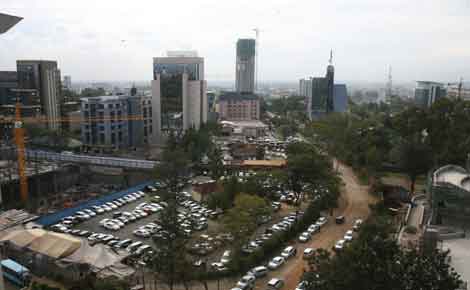 |
|
A section of buildings in Upper Hill taken on 26th May 2014. PHOTO: WILBERFORCE OKWIRI |
NAIROBI: The Kenyan real estate market, Nairobi in particular, is one of the African markets that will benefit from rental growth in 15 leading global cities over the next five years.
A new report by Knight Frank says rising new technology industries and economic recovery are set to drive double digit rental growth in these 15 leading cities.
“The knock on effect of the global cities growth will also see investors targeting new frontiers as they look to growth in emerging markets. We expect to see Africa’s mature markets of Kenya, and Nairobi in particular, Botswana, South Africa and Nigeria to benefit. Cape Town, Johannesburg and Lagos are all strategic hubs in the continent as is Dubai as it services a growing flow of African investment capital,” said James Roberts, head of research at Knight Frank.
New wave
With rents at the start of a new cycle, a new wave of property development is expected to accommodate future economic growth. Building will be focused on new districts, like New York’s Brooklyn, and Nine Elms in London. Skyscrapers will be the preferred means of maximising sites to deliver large volumes of space.
Roberts said: “Premium pricing for real estate is found in those cities with the most high value knowledge workers, which consequently attract the world’s leading corporations.”
These are the ‘Global Cities’ and they are set to experience double digit rental growth in their respective office markets due to substantial demand and restricted supply of new commercial stock.
“The race for knowledge workers and the attractiveness of firms operating in these sectors is borne out by our prediction for office rental growth, with San Francisco’s rents leading the way with an increase of 36.2 per cent by 2019, driven by the effect of Silicon Valley.”
Demand
Demand for Madrid’s office market will see it achieve substantial growth and join Singapore as one of the biggest movers on the top ten list of office markets globally over the next five years.
“A new world of technology revolution with humans providing the creative impetus is generating a renaissance in the commercial property world. Offices are thriving as ideal forums for idea generation while work and home are drawing closer because so many of us want to live near the bright lights,” said Roberts.
“Firms today are scrambling to secure knowledge workers and the trend for a return to urban living has turned the global cities into talent magnets, and consequently multi-national corporations feel it is essential to locate within them.”
Restricted supply of new office stock in conjunction with this heightened demand for commercial space will see vacancy rates diminish in key cities by 2019 with the average vacancy rate dropping to just 6.3 per cent in the top ten cities globally.
“Our data illustrates the opportunity for property investors and developers, who are in a position to exploit the growing trend for urban living across the globe,” explained James Roberts. “There was $202b (Sh18 trillion) of global commercial real estate investment in 2009 and we forecast this amount to increase to $606bn (Sh54 trillion) in 2015, as just a taste of market activity to come”
At the same time, another report, the Knight Frank Skyscraper Index, said Hong Kong skyscrapers were the most expensive in the world.
Stay informed. Subscribe to our newsletter
Capital values of Hong Kong skyscrapers have hit $6,330 (Sh563, 370 in today’s exchange rates) per square foot, sitting 50 per cent higher than Tokyo, the city ranked second in the index.
Lead
Hong Kong’s large lead in the index can be attributed to a variety of factors, such as the restricted geographical area of the city which results in developers having to convert air into ‘land’ and build upwards.
“Skyscrapers are the Lamborghinis of the office world, as investors pay more to own these prestige and high quality buildings,” said Roberts.
“Upper floors in skyscrapers command higher rents compared to office space in low rise buildings, due to the ego appeal of having an office that towers over competitors. Also, the panoramic views are a strong marketing tool, as a client can be taken into a meeting room offering an aeroplane perspective on the city below. Thus, the premium rents on offer justify the high prices investors will pay to own such a property,” he said.
— Information from www.knightfrank.com
 The Standard Group Plc is a
multi-media organization with investments in media platforms spanning newspaper
print operations, television, radio broadcasting, digital and online services. The
Standard Group is recognized as a leading multi-media house in Kenya with a key
influence in matters of national and international interest.
The Standard Group Plc is a
multi-media organization with investments in media platforms spanning newspaper
print operations, television, radio broadcasting, digital and online services. The
Standard Group is recognized as a leading multi-media house in Kenya with a key
influence in matters of national and international interest.
 The Standard Group Plc is a
multi-media organization with investments in media platforms spanning newspaper
print operations, television, radio broadcasting, digital and online services. The
Standard Group is recognized as a leading multi-media house in Kenya with a key
influence in matters of national and international interest.
The Standard Group Plc is a
multi-media organization with investments in media platforms spanning newspaper
print operations, television, radio broadcasting, digital and online services. The
Standard Group is recognized as a leading multi-media house in Kenya with a key
influence in matters of national and international interest.









